
An epiphyte is an organism that grows on the surface of a plant and derives its moisture and nutrients from the air, rain, water or from debris accumulating around it. The plants on which epiphytes grow are called phorophytes. Epiphytes take part in nutrient cycles and add to both the diversity and biomass of the ecosystem in which they occur, like any other organism. They are an important source of food for many species. Typically, the older parts of a plant will have more epiphytes growing on them. Epiphytes differ from parasites in that they grow on other plants for physical support and do not necessarily affect the host negatively. An organism that grows on another organism that is not a plant may be called an epibiont. Epiphytes are usually found in the temperate zone or in the tropics. Epiphyte species make good houseplants due to their minimal water and soil requirements. Epiphytes provide a rich and diverse habitat for other organisms including animals, fungi, bacteria, and myxomycetes.

A lichen is a composite organism that arises from algae or cyanobacteria living among filaments of multiple fungi species in a mutualistic relationship. Lichens have properties different from those of their component organisms. They come in many colors, sizes, and forms and are sometimes plant-like, but are not plants. They may have tiny, leafless branches (fruticose); flat leaf-like structures (foliose); grow crust-like, adhering tightly to a surface (substrate) like a thick coat of paint (crustose); have a powder-like appearance (leprose); or other growth forms.

Crustose is a habit of some types of algae and lichens in which the organism grows tightly appressed to a substrate, forming a biological layer. Crustose adheres very closely to the substrates at all points. Crustose is found on rocks and tree bark. Some species of marine algae of the Rhodophyta, in particular members of the order Corallinales, family Corallinaceae, subfamily Melobesioideae with cell walls containing calcium carbonate grow to great depths in the intertidal zone, forming crusts on various substrates. The substrate can be rocks throughout the intertidal zone, or, as in the case of the Corallinales, reef-building corals, and other living organisms including plants, such as mangroves and animals such as shelled molluscs. The coralline red algae are major members of coral reef communities, cementing the corals together with their crusts. Among the brown algae, the order Ralfsiales comprises two families of crustose algae.
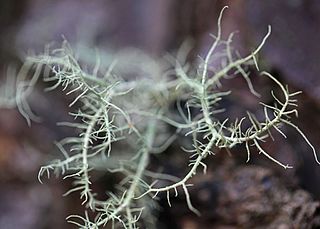
Usnea longissima, known by the name old man's beard or Methuselah's beard lichen, is a lichen in the family Parmeliaceae.
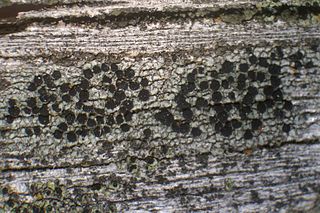
Buellia is a genus of mostly lichen-forming fungi in the family Caliciaceae. The fungi are usually part of a crustose lichen. In this case, the lichen species is given the same name as the fungus. But members may also grow as parasites on lichens (lichenicolous). The algae in the lichen is always a member of the genus Trebouxia.

Amandinea is a genus of lichenized fungi in the family Caliciaceae. Genetic studies indicates that the genus Amandinea and Buellia are the same, although this is not widely accepted.
Lichens of the Sierra Nevada have been little studied. A lichen is a composite organism consisting of a fungus and a photosynthetic partner growing together in a symbiotic relationship.

A fruticose lichen is a form of lichen fungi that is characterized by a coral-like shrubby or bushy growth structure. It is formed from a symbiotic relationship of a photobiont such as green algae or less commonly cyanobacteria and one, two or more mycobionts. Fruticose lichens are not a monophyletic and holophyletic lineage, but is a form encountered in many classes. Fruticose lichens have a complex vegetation structure, and are characterized by an ascending, bushy or pendulous appearance. As with other lichens, many fruticose lichens can endure high degrees of desiccation. They grow slowly and often occur in habitats such as on tree barks, on rock surfaces and on soils in the Arctic and mountain regions.

Crustose lichens are lichens that form a crust which strongly adheres to the substrate, making separation from the substrate impossible without destruction. The basic structure of crustose lichens consists of a cortex layer, an algal layer, and a medulla. The upper cortex layer is differentiated and is usually pigmented. The algal layer lies beneath the cortex. The medulla fastens the lichen to the substrate and is made up of fungal hyphae. The surface of crustose lichens is characterized by branching cracks that periodically close in response to climatic variations such as alternate wetting and drying regimes.
Caloplaca durietzii, or Durietz's orange lichen, a smooth surfaced yellowish orange crustose areolate lichen with elongated lobes that grows on wood or bark in southwestern North America. It is commonly seen growing on old junipers in Joshua Tree National Monument in the Mojave Desert. It is in the Caloplaca fungus genus of the Teloschistaceae family.
Caloplaca nashii is an orange crustose lichen found on calcareous rocks in northern Mexico, southern California, and Baja California. It is the most common of many members of the genus Caloplaca found on rocks in Joshua Tree National Park. It may sometimes be slightly endolithic. It does not have elongated lobes like some other crustose lichens. It has no prothallus. It is in the Caloplaca fungus genus of the Teloschistaceae family.
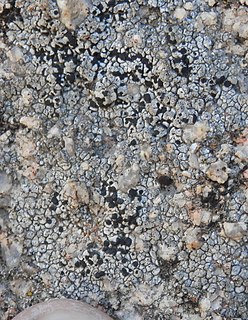
Buellia dispersa is a dull white to beige or dark brown crustose areolate lichen that grows on non-calcareous rock, such as basalt, granite and gneiss, in arid to semi-arid areas of northern Africa, Europe, and southwestern North America. The areolas are distinct, becoming subsquamulose when separated and collecting in irregular patches, otherwise they form rosettes with lobed margins. There is no prothallus. It commonly occurs in the Mojave Desert, Channel Islands, and Santa Monica Mountains, also in the Cuyamaca Mountains, Santa Ana Mountains, and San Jacinto Mountains. It is among the most common lichen species in the Sonoran Desert.
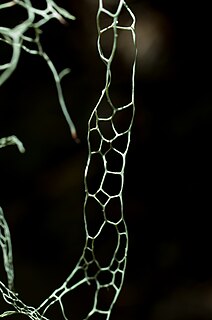
Ramalina menziesii, the lace lichen or fishnet, is a pale yellowish-green to grayish-green foliose lichen. It grows up to a meter long, hanging from bark and twigs in a distinctive net-like or lace-like pattern that is unlike any other lichen in North America. It becomes a deeper green when wet. Apothecia are lecanorine. it is an important food source for deer in the Coast Range of California, and a source of nest material for birds. It is highly variable in its growth form, with branches sometimes so slender as to appear like strands, sometimes tiny, and sometimes large with broadly flattened branches.
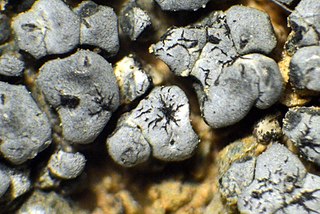
Aspicilia cyanescens is a rough surfaced, bluish-tinged pale gray rimose to areolate crustose lichen, endemic to California. It mostly grows on rock. It is unique among California members of its genus in that it can sometimes be found on growing on bark or wood, especially incense cedar and sometimes on white fir or giant sequoias in the central Sierra Nevada range and southern California mountains. It has a black or bluish or greenish prothallus. The prothallus is usually absent when growing on rock. Each areole commonly has 1-7 roundish to angular apothecia that are .1 - 1.3 mm in diameter. Apothecia have black to blue-black, concave to flat discs, without pruina. Lichen spot tests are all negative.

Rhizocarpales are an order of lichen-forming fungi in the subclass Lecanoromycetidae of the class Lecanoromycetes. It has two families, Rhizocarpaceae and Sporastatiaceae, which contain mostly crustose lichens.

Carbonicola is a small genus of lichen-forming fungi. It is the sole genus in the monogeneric family Carbonicolaceae. The genus, which collectively has an almost cosmopolitan distribution, contains three squamulose lichens that prefer to grow on burned wood in temperate areas of the world.
Amandinea myrticola is a species of corticolous (bark-dwelling), crustose lichen in the family Caliciaceae. Found in Portugal, it was formally described as a new species in 2011 by Mireia Giralt, Pieter van den Boom, and John Elix. The type specimen was collected by the second author from the south side of Barragem de Odivelas (Alentejo); the lichen has also been recorded from another locality in Alentejo. It grows on the smooth bark of Myrtus communis and Pinus twigs. The thallus of the lichen is a smooth to lightly wrinkled grey crust, lacking a prothallus. Amandinea myrticola produces ascospores of the Physconia-type, characterised by a thick septum and median wall thickenings. They are ellipsoid in shape, and typically measure 11–13.5 by 5–6 μm. The lichen does not make any secondary compounds that are detectable with standard chromatographic techniques, and all reactions to standard chemical spot tests are negative.

Bacidina pycnidiata is a species of crustose lichen in the family Ramalinaceae. It is widely distributed in Europe and North Asia. It is characterised by its whitish or cream-coloured pycnidia with long and ostiolar necks.
Biatora radicicola is a species of corticolous (bark-dwelling) and saxicolous (rock-dwelling), crustose lichen in the family Ramalinaceae. It is found in various locations in Europe, where it grows in sheltered and humid microhabitats, often on exposed root bark at the base of trees.
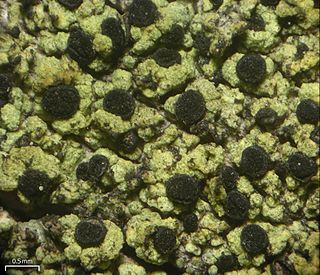
Calicium pinicola is a species of lignicolous (wood-dwelling), crustose lichen in the family Caliciaceae. It is widely distributed in Europe, and also occurs in the United States.















